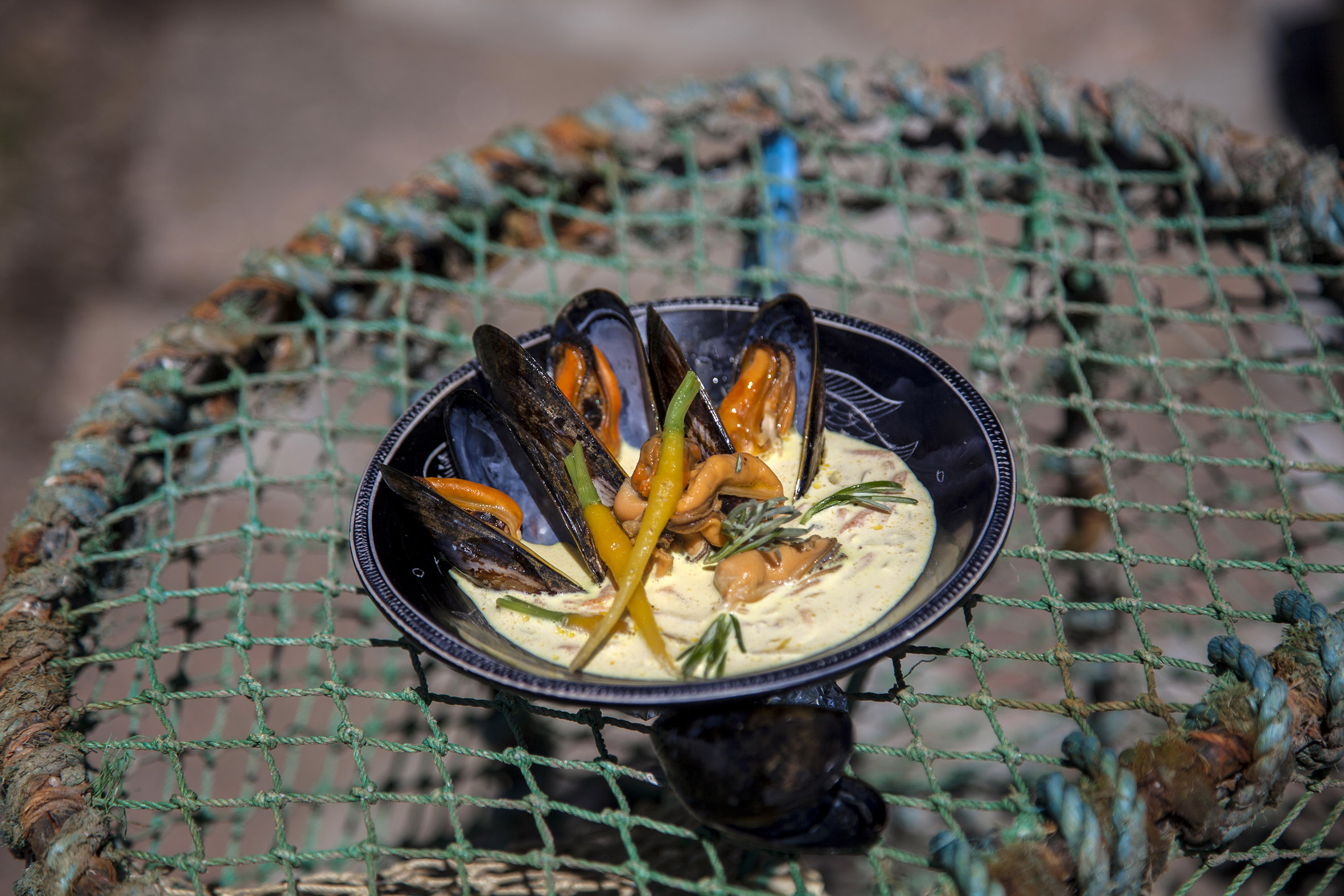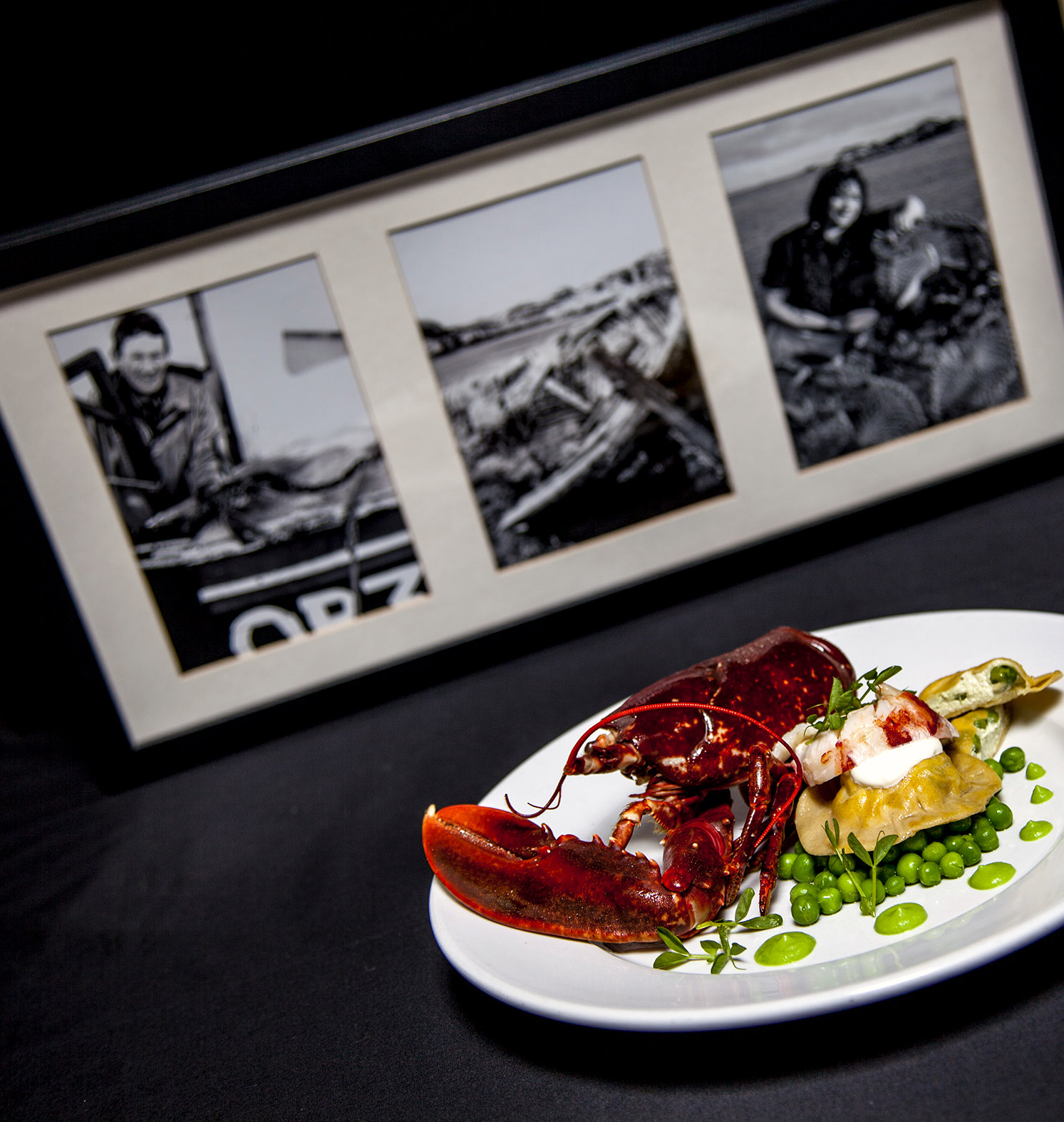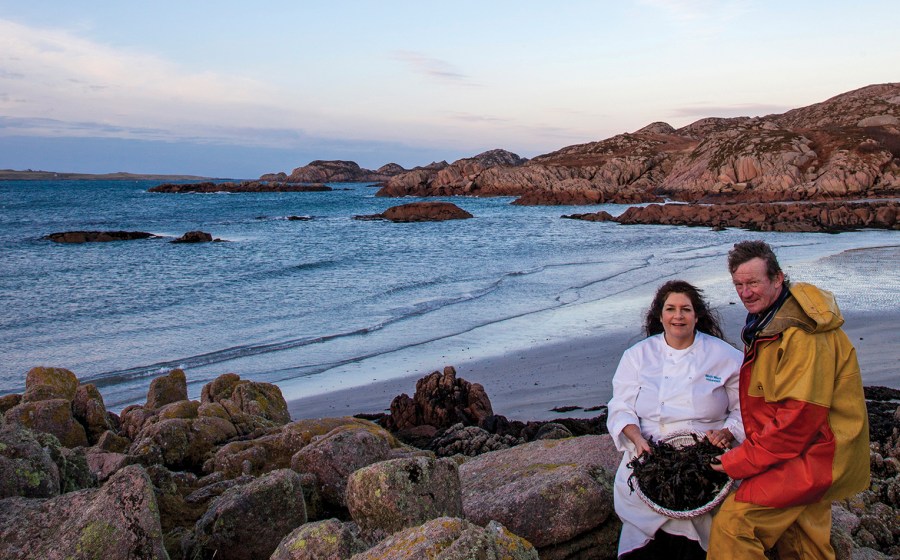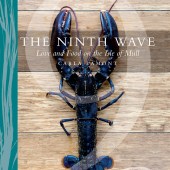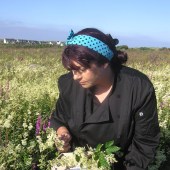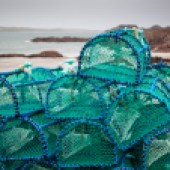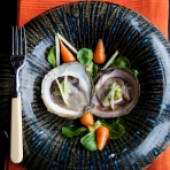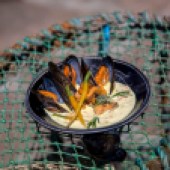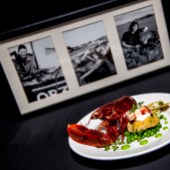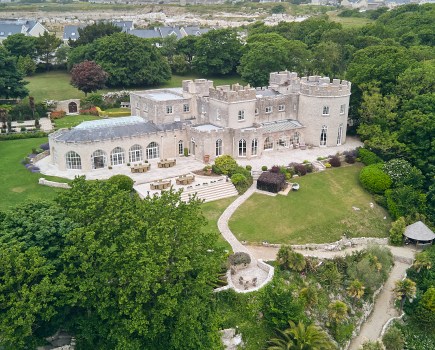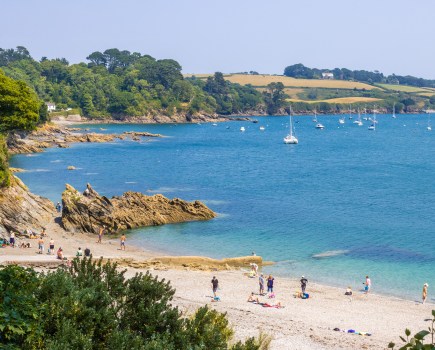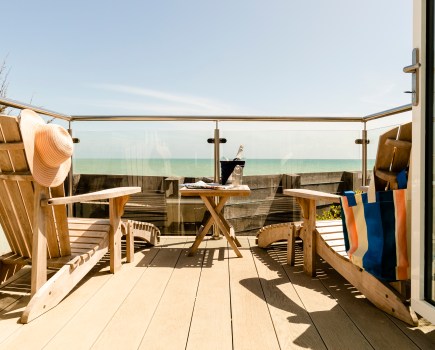With its crumbling castle, wind-scoured cliffs and atmospheric sea mists, the southern half of the Isle of Mull is the kind of place where you wouldn’t expect to come across another living soul, let alone an exciting food scene. And yet, at the tip of this Scottish island’s southwestern peninsula, on a particularly beautiful stretch of headland surrounded by emerald seas, there stands the
Ninth Wave, a restaurant that beat out Michelin-starred competition to win the 2015 Highlands & Islands Food and Drink Restaurant of the Year award.
‘This is an island created to make a chef happy,’ says Carla Lamont, the founding chef, who named the restaurant after a Celtic myth, which tells of ‘a land of other-worldly delights’ that lies beyond the ninth wave.
It was Carla’s innovative use of the island’s ingredients that first caught the judges’ attention. The restaurant takes local-sourcing to an extreme: on any given day, Carla can be spotted foraging for mushrooms, berries, pignuts and wildflowers or picking vegetables from her organic garden. Her fisherman husband John catches lobster and crabs just hours before they arrive on customers’ plates, then come evening swaps his yellow oilskins for a kilt to wait tables. Scallops are hand-dived for by the couple’s neighbour.
In her new book, also called
The Ninth Wave, Carla shares mouthwatering recipes, cooking tips and the charming story of how the restaurant came into existence. At its heart, it’s a simple tale of girl meets boy, of chef meets fisherman.
Originally from Canada, Carla met Mull born-and-bred John while she was working as an assistant cook on the neighbouring island of Iona. An encounter over a pool table in one of Mull’s granite-walled pubs led to an invite for dinner. At first sceptical, given the surrounds – John lived in a bothy farmhouse with only an open peat fire to fight against the cold air rushing in through holes in the tin roof – Carla was knocked off her feet by the three-course meal John prepared: octopus-stuffed tomatoes, followed by a whole lobster, then rhubarb crumble. ‘I was in love,’ says Carla. ‘With the food or the fisherman, it was hard to tell.’
Soon afterwards they got married on Carsaig’s fishing pier and concocted a plan to turn John’s bothy into a restaurant and house with hot water and proper heating. After seven years of wrestling with bank managers and builders, architects and even an archaeologist (they had to hire one to supervise excavating work because their land had once housed a Bronze-age settlement), they finally realised their dream, opening the doors of their establishment in 2009.
Even now, life on their Hebridean island, though mostly idyllic, can be trying for the couple. In the busy summer season, they work gruellingly long hours since they choose to catch and prepare most ingredients by themselves, while bad weather can mean cancelled fishing or scallop-diving outings, necessitating last-minute menu changes. But Carla wouldn’t have it any other way. ‘I can’t think of a place I’d rather be,’ she says. ‘How many chefs get to walk from the kitchen straight out into the countryside and see the sea?’
ULVA OYSTERS WITH GREEN TEA, SAMPHIRE AND SEA LETTUCE
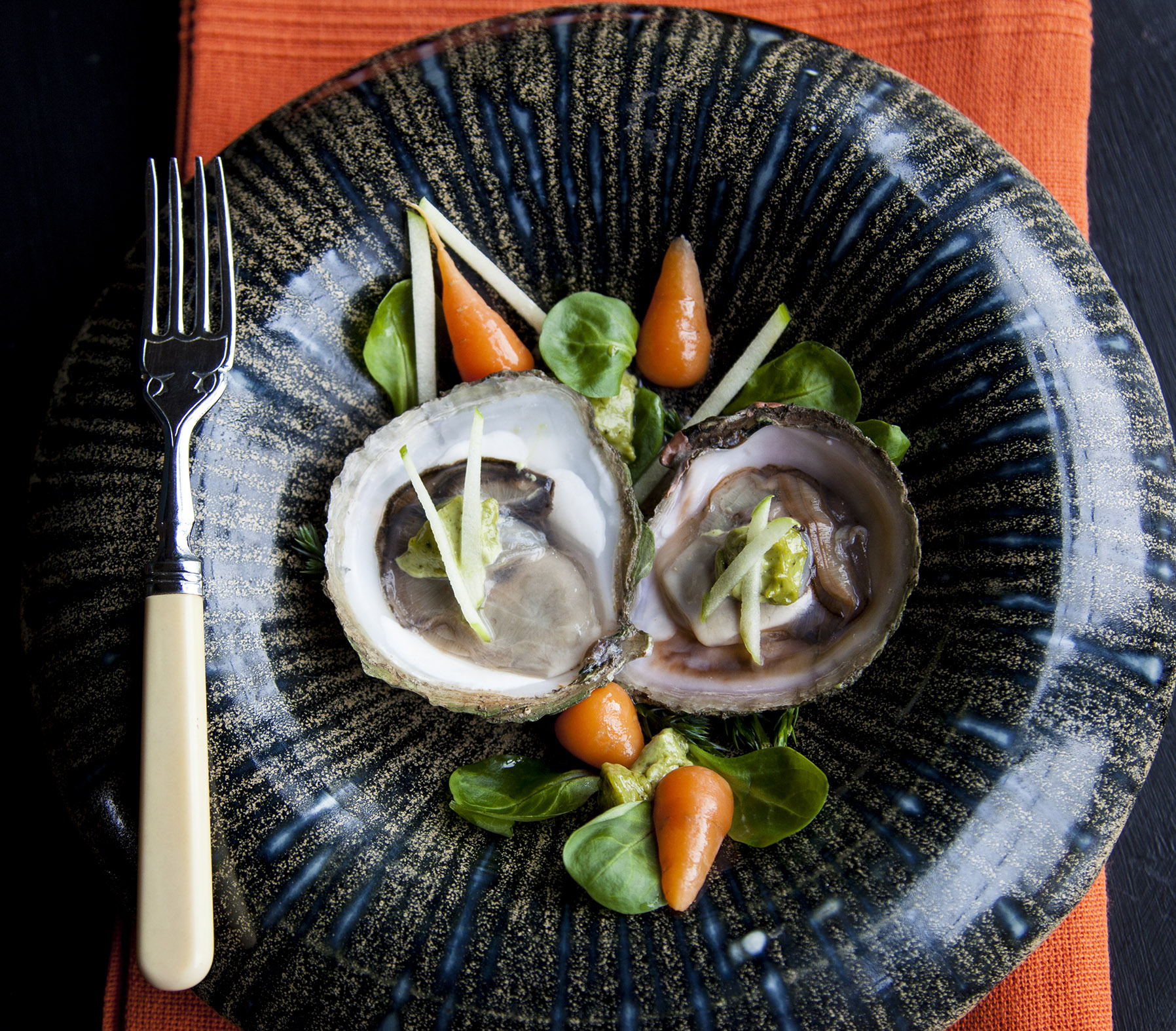
Serves 4
INGREDIENTS
• 8 baby carrots, cleaned
• 30g samphire
• 15g sea lettuce leaves
• 8 fresh shucked oysters, with juices
• 60g Granny Smith apples
• ½ lemon
• 12 baby spinach, washed and stemmed
• 4 large sprigs of chervil
• Merlot sea salt
For the green tea dressing
• A pinch of matcha tea powder
• 2 tsps hot water
• 2 tsps Stark rapeseed oil
• 5 tbsps sour cream
• 2 tsps agave syrup or honey
• 4 tsps mandarin juice
• 1 tsp white wine vinegar
• 1 tsp apple juice
• 1 tsp Worcestershire sauce
• A pinch of sea salt
For the green tea vinaigrette
• A pinch of matcha tea powder
• Agave syrup
• Rapeseed oil
• Cider vinegar
• ½ tsp fish sauce
• Strained juice from the oysters
• Salt
• Sichuan pepper, ground
METHOD
1. Make each of the dressings by whisking the ingredients together and seasoning to taste.
2. Blanch the carrots in boiling, salted water for 3-6 minutes, until just tender. Blanch the samphire in boiling, unsalted water for 20 seconds and drain on a paper towel. Blanch the seaweed in boiling, unsalted water for 1 second.
3. Place the shucked oysters in the green tea vinaigrette 2 minutes before serving.
4. Cut fine matchsticks of Granny Smith apple and cover them with water that has half a lemon squeezed into it. This will keep them from turning brown.
5. Place the spinach, carrots and samphire on serving plates. Put the drained oysters on the plate. Top with a drop of green tea dressing and apple matchsticks. Garnish with sea lettuce, chervil sprigs and Merlot sea salt.
SPICED INVERLUSSA MUSSELS WITH BABY GARDEN CARROTS
Serves 4
INGREDIENTS
• A large pinch of saffron threads
• 12 baby carrots
• 1 tbsp rapeseed oil
• 1 large carrot, peeled and grated
• 3 shallots, finely sliced
• 1 garlic clove, crushed
• 150ml dry white wine
• 50ml white vermouth
• 1kg cleaned mussels, debearded and rinsed
• 1 tsp flour
• ¼ tsp each of dry ground coriander, cumin and ginger
• A pinch of chilli powder
• 250ml double cream
• ½ tsp fish sauce
• Sea salt, to taste
• 2 tbsp fresh coriander, roughly chopped
METHOD
1. Place 2 tablespoons of boiling water over the saffron threads and set aside. Boil a small pot of water on the stove and add the baby carrots. Cook for 3-5 minutes, or until the carrots are just tender. Drain and set aside.
2. Heat the rapeseed oil in a large saucepan with a tight-fitting lid. Cook the grated carrot, shallots and garlic on a gentle heat until soft but not coloured. Add the wine and vermouth and bring to the boil, then simmer for 4 minutes. Mix in the mussels and cover with the lid. Cook for 3 minutes.
3. Make sure that the cooked mussels are open. Drain into a colander placed over a large bowl. Discard any mussels that are still closed. Place the mussels in a covered bowl to keep warm. Strain the mussel liquor through muslin to remove the sediment. Pour the liquor into a clean pan. Simmer the mussel liquor for 7-9 minutes, to reduce the volume by half.
4. Mix the flour, ground coriander, cumin, ginger and chilli powder together in a bowl. Slowly add the double cream while whisking to blend.
5. Add the saffron and its water to this mix. Add the spiced cream, baby carrots and fish sauce to the pan with the mussel liquor, stir and bring to a simmer. Season with salt.
6. Stir in the mussels and serve in large bowls, garnished with the chopped coriander.
MULL LOBSTER WITH GARDEN PEAS AND CROWDIE RAVIOLI
Serves 4
INGREDIENTS
• 2 lobsters, about 750g
• 450g peas
• 1 tbsp butter
• ½ tsp lemon juice
• 1 tbsp double cream
• Sea salt and pepper, to taste
• A handful of pea shoots
For the pasta dough
• 220g semolina
• 180g 00 flour
• 5 eggs
• 6 sorrel leaves, puréed
• A good pinch of salt
For the pasta filling
• 1 shallot, diced
• ½ tsp butter
• 560g Scottish crowdie cheese
• 4 drops white truffle oil
• 1 egg yolk
• 280g shelled, cooked peas
• Sea salt and black pepper
METHOD
1. First, make the dough. Pile the semolina and flour on the worktop and form a well in the middle. Break the eggs into the well and mix with a fork, slowly drawing in the flour from the sides. Add the sorrel purée and season. When it’s all incorporated, knead for about 10-15 minutes, until the dough is smooth and silky. Cover the dough with plastic wrap and leave it to rest for at least 30 minutes.
2. To make the filling, fry the diced shallot in butter over a low heat until translucent. Mash the crowdie with a fork until soft. Add to the rest of the ingredients with the shallots and mix well. Season to taste.
3. Roll the dough quite thinly, 2-3mm, or use a pasta-rolling machine. Cut the rolled dough into squares with a 5cm cookie cutter. Place a smooth, rounded teaspoon of filling in the middle of each. Using a pastry brush, moisten the edges with water and cover with another square of pasta. With your fingers, gently press the pasta together to seal, carefully removing any air pockets around the filling. Crimp edges of the pastry with your fingers or a fork to make sure they are sealed.
4. Place the humanely killed lobsters in the large pot of boiling water. The lobsters will take 8 minutes to cook; remove with tongs. After 4 minutes, add the fresh peas to a smaller pot of well-salted boiling water. Boil for 3-4 minutes until tender but still bright green.
5. Place the ravioli gently in the lobster water and simmer for 3-4 minutes until the pasta is cooked to your taste.
6. Strain the peas and stir in the butter. Keep half of them warm, covered in the pot. Take the other half of the peas and whizz them up with the lemon using a hand blender. This should become a fine purée. Add the cream and blend again. Season to taste.
7. Place the lobster, peas, pea purée and ravioli on the plate. Put a spoon of truffle dressing on the ravioli and garnish with pea shoots.
For more recipes and food stories from around the British Isles, click here. Don’t miss our Food and Drink special December issue of coast
magazine.

